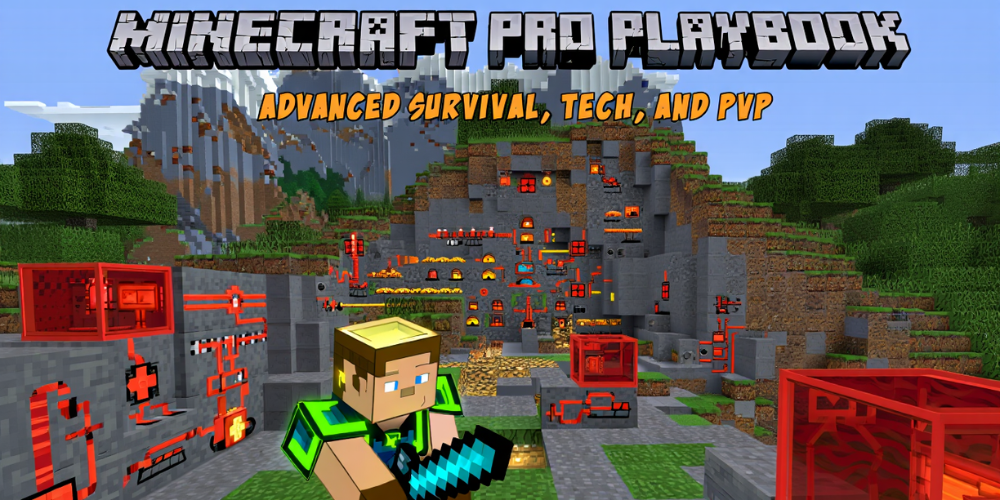Minecraft Pro Playbook: Advanced Survival, Tech, and PvP
2025-11-12

This guide is for players who already know the basics and want pro consistency. We will cover fast routes to iron and diamonds, smart villager setups, powerful farms, Redstone patterns, PvP habits, and clean endgame planning. You will learn how to turn any seed into a stable world, how to reduce risk in Hardcore, and how to keep servers smooth and friendly without losing efficiency.
The advice targets Java 1.20+ (most tips apply to Bedrock too). We’ll focus on reliable systems: shields and timing in combat, trading halls that never jam, chunk‑safe farms, and network‑friendly settings. If you follow the order—early game power, midgame upgrades, Nether/End unlocks, then automation—you will grow fast with fewer setbacks.
World Setup, Performance, and Tools
Pick a version and stick to it; mechanics change. On Java, use a performance mod pack for stable frames and view distance you can actually support. Set render distance modestly to keep tick timing smooth in fights and near farms. Learn F3 data: coordinates for navigation, biome for spawns, light levels to stop mob spawns, and chunk borders to place Redstone reliably. Use a seed map only if you want a planned run; otherwise, map as you explore and set nether anchors early for fast travel.
Early Progression That Scales
Two strong openings exist. The village start gives beds, food, and instant trades; lock a toolsmith and armorer for iron gear and a shield. The iron rush works in any seed: punch trees, craft a shield first, cook food, and dive a surface cave for iron, coal, and copper. With a shield, you can handle skeletons and creepers safely by timing blocks and spacing. Aim to leave the first day with iron tools, chestplate, boots, a stack of cooked food, and enough torches to secure a base cave or a small walled village plot.
Midgame Power: Enchants, Villagers, and XP
Enchanting carries the midgame. Build a 15‑shelf table and start with Efficiency on pickaxes, Protection on armor, and a Fortune pick for ores. Then pivot to villagers for precision: set up a trading hall with job blocks behind cells so you can refresh offers. Lock a librarian with Mending and Unbreaking; add Sharpness, Protection, Efficiency, and Silk Touch. For XP, choose a clean loop: a mob spawner grinder, a basic enderman farm after the dragon, or a village crops‑to‑emeralds cycle with a fletcher and farmer. Keep the hall chunk‑aligned and well lit to prevent jams and stray spawns.
Nether and End Routing
Travel early to the Nether when you have iron and a bow or crossbow. Mark your portal with coordinates and build safe paths with railings. Your goals are blaze rods from a fortress and pearls from warped forests or cleric trades. If you find a bastion and feel confident, secure gold and trade safely with trapped piglins. Once you have rods and pearls, brew fire resistance and slow falling for the End. In the dragon fight, destroy crystals from cover or with a bow, block breath with a shield, and use slow falling to avoid knockback launches. After the win, raid End cities for Elytra and Shulker shells; the mobility and storage upgrade your entire game.
Redstone Fundamentals That Never Break
Think in signals, not gadgets. Redstone dust carries power; repeaters delay and direct; comparators read container states; observers detect changes; pistons move blocks; hoppers move items. Build on solid, chunk‑aligned footprints to prevent edge unload bugs. Use water streams or ice lanes with item filters for storage: a comparator on a hopper, a locked pattern stack, and a redstone line that shunts extra items down the bus. Keep clocks simple and toggleable; an always‑on clock near your base adds lag and noise. Label inputs and add a manual override lever to every automated machine.
Farms That Win Every World
Start with crops in a villager breeder to seed emerald trades, then add iron (zombie‑based or scare mechanics), and a simple mob farm above an ocean for stable rates. For XP, an enderman farm is efficient once you have End access; before that, use a spawner grinder. In the Nether, a gold farm above the roof is strong if your server allows it; pair with bartering for quartz, blackstone, and utility items. A raid farm is late‑game but top tier for emeralds and totems—build it with careful spawnproofing and a safe kill chamber. Always light, slab, or button surrounding areas to direct spawns and protect performance.
Storage, Base Design, and Logistics
Plan your base around movement and noise. Put loud or ticking farms far from your main hall. Centralize storage with color‑coded halls and an item bus that auto‑sorts common blocks. Keep a “trash lane” with a toggle so nothing deletes by accident. Add a hub of nether portals linked to key biomes and your outposts. Use maps, lecterns with notes, and clear paths to every utility area: enchanting, brewing, smithing, and villager halls. Your time saved walking is time you put into exploration or projects.
PvE and PvP Combat, Clean and Safe
For PvE, shield timing is king. Approach skeletons in zigzags, block at rhythm, and counter between shots. Strafe creepers, block explosions with the shield, and keep distance with ranged hits. For PvP, understand version combat: 1.9+ rewards timing and spacing; 1.8 relies on knockback control and hit selection. Learn sprint resets, short strafes, and hotbar swaps without looking down. Potions win trades: speed to control distance, strength for burst, and regeneration in longer duels. Keep pearls ready as a panic tool, and never fight uphill against a bow user without cover.
Hardcore Risk Management
In Hardcore, think like a pilot: redundancy over style. Carry a water bucket, blocks, and a ranged option at all times. Never dig straight down; dig a two‑wide stair or drop a probe shaft with ladders. Enter caves with arrows and torches, and back out if you feel rushed. In the Nether, drink fire resistance before bridges or bastions. In the End, keep slow falling active during the fight and bridge with guard rails. Back up your world if rules allow, or at least keep a “gear kit” chest at base so a mistake does not end your long‑term plans in regular survival.
Multiplayer Etiquette and Server Health
On servers, communicate. Claim a region politely, mark your farms, and share rates and on/off rules. Use chunk‑friendly designs and add kill switches so idle farms do not run 24/7. Offer trading posts with labeled prices and a suggestion board. For PvP servers, agree on rules about spawn safety and kit limits. Keep your client modest—extreme render distance or heavy shaders can hurt performance in crowded hubs. Healthy servers last longer, and your builds gain value when the community stays active.
Practice, Review, and Goals
Make practice short and focused. Run a 10‑minute block: block timing on mobs, bow flicks on targets, and clutch routines with water buckets and pearls from height. Review deaths or gear losses with one question: what warning did I ignore? Set weekly goals like “unlock Elytra,” “finish iron farm,” or “link three nether hubs,” then break them into daily steps. A small logbook helps you track wins and avoid repeating mistakes. Pro consistency comes from tiny habits done every session.
Conclusion
Play with a plan and you will feel the world bend in your favor. Stabilize your early game, unlock enchants and trades, secure Nether and End mobility, then automate what you use most. Keep Redstone simple and chunk‑aware, fight with timing and space, and carry safety tools in Hardcore. On servers, be clear, polite, and performance‑minded. If you practice short, honest blocks and set small goals, you will turn every seed into a long, rich world—and every session into real progress.
- Shield first, then weapon; timing beats panic in any fight.
- Lock Mending and Unbreaking early; Elytra plus shulkers change everything.
- Chunk‑align farms, add kill switches, and keep clocks toggleable.
- Nether hubs save hours; build them as soon as you can travel safely.
- Review one mistake per session and write the fix you will apply tomorrow.






